University Students donate Shoes to over 300 Children
 Student athletes from the University of Central Arkansas shoes to over 300 Conway children through the international project Shoes of Hope. The project aims to bring children together by washing their feet and then giving them a new pair of shoes. For this event, the University’s athletes raised over $5,000. Graham Gibbs of Samaritan’s Feet shared, “60 percent of kids K through 12 in Arkansas are either on or eligible for free and reduced lunches. So that’s a demographic stat that we use to gauge need. If they’re needing food, they’re needing clothes, they’re needing shoes.”
Student athletes from the University of Central Arkansas shoes to over 300 Conway children through the international project Shoes of Hope. The project aims to bring children together by washing their feet and then giving them a new pair of shoes. For this event, the University’s athletes raised over $5,000. Graham Gibbs of Samaritan’s Feet shared, “60 percent of kids K through 12 in Arkansas are either on or eligible for free and reduced lunches. So that’s a demographic stat that we use to gauge need. If they’re needing food, they’re needing clothes, they’re needing shoes.”
Looking out for potential foot and ankle injuries as well as general health is vital in maintaining proper development in children’s feet. If you have any concerns contact Dr. Joshua David Scoll of Pennsylvania. Our doctorwill treat your foot and ankle needs.
Keeping Children's Feet Healthy
Having healthy feet in childhood can help prevent medical problems later in life, namely in the back and legs. As children grow, their feet require different types of care from birth to school-age.
Although babies do not walk yet, it is still very important to take care of their feet.
- Avoid putting tight shoes or socks on his or her feet
- Allow the baby to stretch and kick his or her feet to feel comfortable
As a toddler, kids are now on the move and begin to develop differently. At this age toddlers are getting a feel for walking, so don’t be alarmed if your toddler is unsteady or ‘walks funny’. Be sure the child wears comfortable and protective shoes so that they can grow into their feet properly.
As your child gets older, it is important to teach them how to take care of their feet
- Show them proper hygiene to prevent infections such as fungus
- Be watchful of any pain or injury
- Have all injuries checked by a doctor as soon as possible
- Comfortable, protective shoes should always be worn, especially at play
Children of all ages are constantly developing and growing, and as a parent you want to make sure that nothing is hindering their maturation.
If you have any questions please feel free to contact our offices located in Philadelphia and Bensalem, PA. We offer the newest diagnostic tools and technology to treat your foot and ankle needs.
Preparing an Emergency Kit for Diabetic Patients Key to Good Health
 To ensure adequate care during emergency situations, diabetics should prepare an emergency kit that contains the necessary supplies, medications, and especially foods. Rebecca Ercums, Lifestyle Education Assistance Program Diabetes Health Educator, shares, “In your emergency kit, include foods that meet your dietary needs and help you maintain good blood sugar levels. Crackers; peanut butter; powdered milk; low sugar cereal; juice; hard candy or glucose tablets; canned tuna, salmon, and chicken; and nuts are good choices.”.
To ensure adequate care during emergency situations, diabetics should prepare an emergency kit that contains the necessary supplies, medications, and especially foods. Rebecca Ercums, Lifestyle Education Assistance Program Diabetes Health Educator, shares, “In your emergency kit, include foods that meet your dietary needs and help you maintain good blood sugar levels. Crackers; peanut butter; powdered milk; low sugar cereal; juice; hard candy or glucose tablets; canned tuna, salmon, and chicken; and nuts are good choices.”.
Diabetic foot care is important in preventing foot complications such as ulcers or amputation. If you are suffering from diabetes or have any other concerns about your feet, contact Dr. Joshua David Scoll of Pennsylvania. Our doctor will diagnose and treat your foot and ankle needs.
Diabetic Foot Care
Diabetes affects millions of people every year. Diabetes can damage blood vessels in many parts of the body, including the feet. Because of this, taking care of your feet is essential if you have diabetes, and having a podiatrist help monitor your foot health is highly recommended.
The Importance of Caring for Your Feet
- Routinely inspect your feet for bruises or sores.
- Wear socks that fit your feet comfortably.
- Wear comfortable shoes that provide adequate support.
Patients with diabetes should have their doctor monitor their blood levels because blood sugar levels play such a huge role in diabetic care. Monitoring these levels on a regular basis is highly advised.
It is always best to inform your healthcare professional of any concerns you may have regarding your feet, especially for diabetic patients. Early treatment and routine foot examinations are keys to maintaining proper health, especially because severe complications can arise if proper treatment is not applied.
If you have any questions please feel free to contact our offices located in Philadelphia and Bensalem, PA. We offer the newest diagnostic tools and technology to treat your foot and ankle needs.
Seahawks Lose Tharold Simon To Surgery
 Tharold Simon of the Seattle Seahawks may have to face surgery due to a dislocated toe. Due to the injury the running back has since been placed on the team reserve that essentially ends his season. Coach Pete Carroll stated, “His nature has given him a toe that’s got some issues and we’ve just got to work through it.” In the meantime, rookie Rod Smith will take Simon’s place.
Tharold Simon of the Seattle Seahawks may have to face surgery due to a dislocated toe. Due to the injury the running back has since been placed on the team reserve that essentially ends his season. Coach Pete Carroll stated, “His nature has given him a toe that’s got some issues and we’ve just got to work through it.” In the meantime, rookie Rod Smith will take Simon’s place.
Foot surgery is sometimes necessary to fix a foot ailment. If you have any concerns about your foot and ankle needs contact Dr. Joshua David Scoll of Pennsylvania. Our doctor will treat your foot and ankle needs.
When Is Surgery Necessary?
Foot and ankle surgery is generally reserved for cases in which less invasive, conservative procedures have failed to help with the problem. Some of the cases in which surgery may be necessary are:
- Removing foot deformities like bone spurs and bunions
- Severe arthritis that has caused bone issues
- Cosmetic reconstruction
What Types of Surgery Are There?
The type of surgery you receive will depend on the nature of the problem you have. Some of the possible surgeries include:
- Bunionectomy for painful bunions
- Surgical fusion for realignment of bones
- Neuropathy decompression surgery to treat nerve damage
Benefits of Surgery
Although surgery is usually a last resort, it can provide more complete pain relief compared to non-surgical methods and may allow you to finally resume full activity.
Surgical techniques have also become increasingly sophisticated. Techniques like endoscopic surgery allow for smaller incisions and faster recovery times.
If you have any questions please feel free to contact our offices located in Philadelphia and Bensalem, PA. We offer the newest diagnostic tools and technology to treat your foot and ankle needs.
Refugees in Hungary Suffering from Foot Ailments such as Corns
 The unfortunate refugee crisis taking place in Hungary has become very visible on each refugee’s feet. After walking for days on end in worn down shoes, corns and calluses have become the norm. By not having the ability to take care of their feet, massive corns and calluses and swollen and weathered soles are negatively affecting the overall health of these refugees. Fortunately, volunteer efforts are bringing positive progress in this crisis and will hopefully eventually lead to a swift resolution.
The unfortunate refugee crisis taking place in Hungary has become very visible on each refugee’s feet. After walking for days on end in worn down shoes, corns and calluses have become the norm. By not having the ability to take care of their feet, massive corns and calluses and swollen and weathered soles are negatively affecting the overall health of these refugees. Fortunately, volunteer efforts are bringing positive progress in this crisis and will hopefully eventually lead to a swift resolution.
Corns can be a huge nuisance for the feet. If you have any foot or ankle concerns contact Dr. Joshua David Scoll of Bensalem and Philadelphia, PA. Our doctors will attend to your foot and ankle needs.
Corns: What are they? And how do you get rid of them?
Corns can be described as areas of the skin that have thickened to the point of becoming painful or irritating. They are often layers and layers of the skin that have become dry and rough, and are normally smaller than calluses.
Ways to Prevent Corns
There are many ways to get rid of painful corns such as wearing:
- Well-fitting socks
- Comfortable shoes that are not tight around your foot
- Shoes that offer support
Treating Corns
Treatment of corns involves removing the dead skin that has built up in the specific area of the foot. Salicylic acid can help in getting rid of these corns because it dissolves keratin, which is the protein that makes up a good majority of corns. Podiatrists recommend that people with diabetes not use salicylic acid but should consult with their podiatrist regarding the treatment of corns.
If you have any questions feel free to contact our offices located in Philadelphia and Bensalem, PA. We offer the newest diagnostic tools and technologies to treat your foot and ankle needs.
Heavy Sports Involvement Can Result in Plantar Fasciitis
 Nearly 2 million people in the United States are affected by plantar fasciitis each year. While anyone can get plantar fasciitis, some say there has been an increase in recent years due to heavy sports involvement. Plantar fasciitis occurs when the band stretching from the toes to the heels and is often referred to as “heel pain syndrome.” While sports such as running seems to be a major cause of the condition, those that are often on their feet, athletes, and improper shoe wearers can all suffer. Pain from an overused fascia can go undetected for a long time until the band becomes so strained and inflamed.
Nearly 2 million people in the United States are affected by plantar fasciitis each year. While anyone can get plantar fasciitis, some say there has been an increase in recent years due to heavy sports involvement. Plantar fasciitis occurs when the band stretching from the toes to the heels and is often referred to as “heel pain syndrome.” While sports such as running seems to be a major cause of the condition, those that are often on their feet, athletes, and improper shoe wearers can all suffer. Pain from an overused fascia can go undetected for a long time until the band becomes so strained and inflamed.
Plantar fasciitis can be very painful and inconvenient. If you are experiencing heel pain or symptoms of plantar fasciitis, visit Dr. Joshua David Scoll of Pennsylvania. Our doctors can treat your heel pain as well as any other foot or ankle condition.
What is Plantar Fasciitis?
Plantar fasciitis is the inflammation of a the thick band of tissue that runs along the bottom of your foot, known as the plantar fascia, and causes mild to severe heel pain.
What Causes Plantar Fasciitis?
· Excessive running
· Non-supportive shoes
· Overpronation
· Repeated stretching and tearing of the plantar fascia
How Can It Be Treated?
· Conservative measures – anti-inflammatories, ice packs, stretching exercises, physical therapy, orthotic devices
· Shockwave therapy – sound waves are sent to the affected area to facilitate healing and are usually used for chronic cases of plantar fasciitis
· Surgery – usually only used as a last resort when all else fails. The plantar fascia can be surgically detached from the heel
While very treatable, plantar fasciitis is definitely not something that should be ignored. Especially in severe cases, speaking to your doctor right away is highly recommended to avoid complications and severe heel pain. Your podiatrist can work with you to provide the appropriate treatment options tailored to your condition.
If you have any questions, please contact our offices in Philadelphia and Bensalem, PA. We offer the newest diagnostic and treatment technologies for all your foot and ankle injuries.
Pregnant Woman Treated Poorly By Fellow Passenger on Train
 Mhari-Claire Doolan had boarded a train to Manchester in late August when she found a businessman sitting in a seat she had already reserved. Doolan is 34 weeks pregnant with her first child. “I told him I had that seat booked and positioned myself so that he could see I was pregnant but he just ignored me,” she shared. “My back ached, my feet ached and I felt sick. I was in a lot of pain but luckily a seat eventually came free.” A spokesman for the train company stated, “We would expect our customers to be polite and courteous to their fellow passengers and are disappointed to learn of her experience during her journey with us.”
Mhari-Claire Doolan had boarded a train to Manchester in late August when she found a businessman sitting in a seat she had already reserved. Doolan is 34 weeks pregnant with her first child. “I told him I had that seat booked and positioned myself so that he could see I was pregnant but he just ignored me,” she shared. “My back ached, my feet ached and I felt sick. I was in a lot of pain but luckily a seat eventually came free.” A spokesman for the train company stated, “We would expect our customers to be polite and courteous to their fellow passengers and are disappointed to learn of her experience during her journey with us.”
Pregnant women are susceptible to aching and swollen feet and should be treated with care. For more information about other cures for swollen feet during pregnancy, speak to Dr. Joshua David Scoll of Pennsylvania. Our doctor will assist you with all of your foot and ankle concerns and answer any of your related questions.
What foot problems can arise during pregnancy?
One problem that can occur is over-pronation, which occurs when the arch of the foot flattens and tends to roll inward. This can cause pain and discomfort in your heels while you’re walking or even just standing up, trying to support your baby.
Another problem is edema, or swelling in the extremities. This often affects the feet during pregnancy, but tends to occur in the later stages.
How can I keep my feet healthy during pregnancy?
- Wearing orthotics can provide extra support for the feet and help distribute weight evenly
- Minimize the amount of time spent walking barefoot
- Wear shoes with good arch support
- Wear shoes that allow for good circulation to the feet
- Elevate feet if you experience swelling
- Massage your feet
- Get regular, light exercise, such as walking, to promote blood circulation to the feet
If you have any questions, please contact our offices located in Philadelphia and Bensalem, PA. We offer the newest diagnostic and treatment technologies for all your foot care needs.
Jacoby Jones Suffers Minor Ankle Sprain Early in the Season
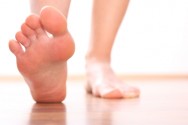 Jacboy Jones, wide receiver for the Chargers, has been temporarily sidelined for what appears to be a minor ankle sprain. The injury occurred during the Week 1 win over the Lions. While Jones is a key player for the team, Branden Oliver and Keenan Allen are likely to take over for him until he is ready and healthy enough to join the team again. Should Oliver and Allen not be available or prepared fourth receiver Dontrelle Inman will step up.
Jacboy Jones, wide receiver for the Chargers, has been temporarily sidelined for what appears to be a minor ankle sprain. The injury occurred during the Week 1 win over the Lions. While Jones is a key player for the team, Branden Oliver and Keenan Allen are likely to take over for him until he is ready and healthy enough to join the team again. Should Oliver and Allen not be available or prepared fourth receiver Dontrelle Inman will step up.
Ankle sprains are common, but need immediate attention. If you have any concerns about your potential ankle sprain contact Dr. Joshua David Scoll of Pennsylvania. Our doctor will treat your foot and ankle needs.
How Does an Ankle Sprain Occur?
Ankle sprains take place when the ligaments in your ankle are torn or stretched beyond their limits. There are multiple ways that the ankle can become injured, including twisting or rolling over onto your ankle, putting undue stress on it, or causing trauma to the ankle itself.
What are the Symptoms?
- Mild to moderate bruising
- Limited mobility
- Swelling
- Discoloration of the skin (depending on severity)
Preventing a Sprain
- Wearing appropriate shoes for the occasion
- Stretching before exercises and sports
- Knowing your limits can aid in prevention
Treatment of a Sprain
Treatment of a sprain depends on the severity. Many times, people are told to rest and remain off their feet completely, while others are given an air cast. If the sprain is very severe, surgery may be required.
If you have suffered an ankle sprain previously, you may want to consider additional support such as a brace and regular exercises to strengthen the ankle.
If you have any questions please feel free to contact our offices located in Philadelphia and Bensalem, PA. We offer the newest diagnostic tools and technology to treat your foot and ankle needs.
Cody Waldrop Out for the Season due to Broken Ankle
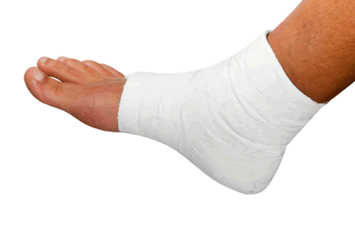 Cody Waldrop, offensive lineman of South Carolina University will be off of the field until later in the season due to a broken ankle. Although Waldrop is a starter for the team, he has only played four games since his off season knee surgery. Although Coach Steve Spurrier said Waldrop may be back later in the season, which is just an estimate as the extent of the injury is still unknown.
Cody Waldrop, offensive lineman of South Carolina University will be off of the field until later in the season due to a broken ankle. Although Waldrop is a starter for the team, he has only played four games since his off season knee surgery. Although Coach Steve Spurrier said Waldrop may be back later in the season, which is just an estimate as the extent of the injury is still unknown.
Broken Ankles are serious injuries that need immediate attention. If you have any concerns with your ankles please contact Dr. Joshua David Scoll at Pennsylvania. Our doctor will treat your foot and ankle needs.
Broken Ankles
A broken ankle occurs when a person fractures the bones in the lower leg and ankle area. These bones are both attached at the bottom of the leg and combine to form what we know to be our ankle.
Ankle fractures are very common since they occur in an area that suffers a lot of weight bearing and stress; therefore this area is more prone to suffering from fractures. There some obvious signs when a person experiences a fractured ankle and the following symptoms may be present.
Symptoms of a Fractured Ankle
- Excessive pain when the area is touched or when any pressure is placed on the ankle.
- Swelling around the area.
- Bruising of the area.
- Area appears to be deformed.
The sooner your receive treatment the better. So if you suspect an ankle fracture, seek treatment as soon as possible.
If you have any concerns about your feet or ankles please feel free to contact our offices located in Philadelphia and Bensalem, PA. We offer the newest diagnostic tools and technology to treat your foot and ankle needs.
Surgery Not the Only Option for Hammertoes
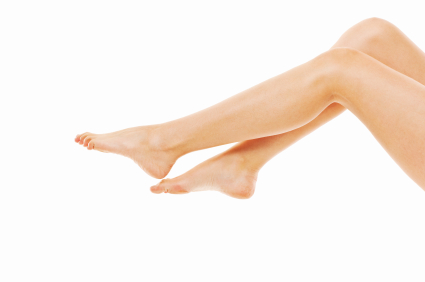 Many patients often have the misconception that conditions such as hammertoes can only be treated and cured through surgery. But such minor conditions can effectively be managed with treatments such as ultrasound-guided injections, which send anti-inflammatory medication directly to the source of pain, and shock wave therapy, which promotes soft-tissue healing. Physical therapy and insoles that ease pressure on the foot are other nonsurgical treatments that have proven successful.
Many patients often have the misconception that conditions such as hammertoes can only be treated and cured through surgery. But such minor conditions can effectively be managed with treatments such as ultrasound-guided injections, which send anti-inflammatory medication directly to the source of pain, and shock wave therapy, which promotes soft-tissue healing. Physical therapy and insoles that ease pressure on the foot are other nonsurgical treatments that have proven successful.
Hammertoes can be a painful condition to live with. If you are suffering from hammertoes, contact Dr. Joshus David Scoll of Pennsylvania. Our doctor will treat your foot and ankle needs.
Hammertoe
Hammertoe is a foot deformity that affects the joints of the second, third, fourth, or fifth toes of your feet. It is a painful foot condition in which these toes curl and arch up, which can often lead to pain when wearing footwear.
Symptoms
- Pain in the affected toes
- Development of corns or calluses due to friction
- Inflammation
- Redness
- Contracture of the toes
Causes
- Genetics – people who are genetically predisposed to hammertoe are often more susceptible
- Arthritis – because arthritis affects the joints in your toes, further deformities stemming from arthritis can occur
- Trauma – direct trauma to the toes could potentially lead to hammertoe
- Ill-fitting shoes – undue pressure on the front of the toes from ill-fitting shoes can potentially lead to the development of hammertoe
Treatment
- Orthotics – custom made inserts can be used to help relieve pressure placed on the toes and therefore relieve some of the pain associated with it
- Medications – oral medications such as anti-inflammatories or NSAIDs could be used to treat the pain and inflammation hammertoes causes. Injections of corticosteroids are also sometimes used
- Surgery – in more severe cases where the hammertoes have become more rigid, foot surgery is a potential option
If you have any questions please contact our offices located in Philadelphia and Bensalem, PA. We offer the newest diagnostic and treatment technologies for all your foot and ankle needs.
Supportive Orthotic Flip-Flop Created for Women
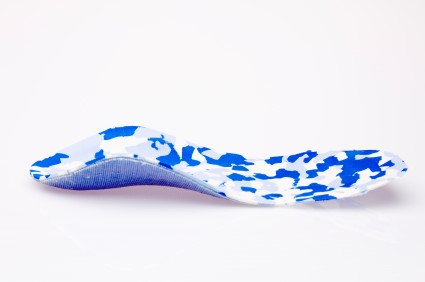 Foot Levelers, a custom orthotic manufacturer, has recently come out with a new orthotic flip-flop known as Bling. The flip-flop has been created for women because of its rhinestone straps and its comfortable suede top cover. “For years there’s been a tremendous need for a flip-flop that doesn’t do harm to the body, but instead helps people achieve total body wellness,” stated Senior Vice President Dawn Galbraith. Foot Levelers Bling flip-flop is made with an EVA mid-layer, cushioning, and a rubber sole for non-slipping.
Foot Levelers, a custom orthotic manufacturer, has recently come out with a new orthotic flip-flop known as Bling. The flip-flop has been created for women because of its rhinestone straps and its comfortable suede top cover. “For years there’s been a tremendous need for a flip-flop that doesn’t do harm to the body, but instead helps people achieve total body wellness,” stated Senior Vice President Dawn Galbraith. Foot Levelers Bling flip-flop is made with an EVA mid-layer, cushioning, and a rubber sole for non-slipping.
Orthotics can help provide support and prevent injury to your feet. If you have any questions contact Dr. Joshua David Scoll of Pennsylvania. Our doctor will treat your foot and ankle needs.
What are Orthotics?
Orthotics are inserts you can place into your shoes to help with a variety of foot problems such as flat feet or foot pain. Orthotics provide relief and comfort for minor foot and heel pain, but can’t correct serious biomechanical problems in your feet.
Over-the-Counter Inserts
Orthotics come in a wide variety of over-the-counter inserts that are used to treat foot pain, heel pain, and minor problems. For example, arch supports can be inserted into your shoes to help correct over arched or flat feet, while gel insoles are often used because they provide comfort and relief from foot and heel pain by alleviating pressure.
Prescription Orthotics
If over-the-counter inserts don’t work for you, or if you have a more severe foot issue, it is possible to have your podiatrist prescribe custom orthotics. These high quality inserts are designed to treat problems such as abnormal motion, plantar fasciitis, and more severe heel pain.
If you are experiencing minor to severe foot or heel pain, it’s recommended to speak with your podiatrist on the possibilities of using orthotics. A podiatrist can determine which type of orthotic is right for you and allow you to take the first steps towards being pain free.
If you have any questions please feel free to contact our offices located in Philadelphia and Bensalem, PA. We offer the newest diagnostic tools and technologies to treat your foot and ankle needs.
The Feet Need Their Own Strengthening and Exercise to Maintain Body
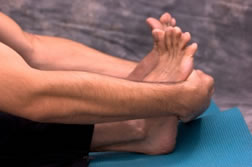 While running is a great exercise to help the body, the feet need their own form of exercise to maintain stability and strength for the body. Exercising the arch, toes, and legs regularly can better your full body routine as well as help preventing injury. The big toe press, pressing your big toe on the floor while reaching with your four other toes in an eight second hold can help strengthen the arch of the foot. Moving the toes away from each other without curling or extending them in a toe splay can be practiced throughout the day for foot strengthening. Calf raises and leg swings can be performed 15 times daily to regulate foot strength.
While running is a great exercise to help the body, the feet need their own form of exercise to maintain stability and strength for the body. Exercising the arch, toes, and legs regularly can better your full body routine as well as help preventing injury. The big toe press, pressing your big toe on the floor while reaching with your four other toes in an eight second hold can help strengthen the arch of the foot. Moving the toes away from each other without curling or extending them in a toe splay can be practiced throughout the day for foot strengthening. Calf raises and leg swings can be performed 15 times daily to regulate foot strength.
Exercising your feet regularly with the proper foot wear is a great way to prevent injuries. If you have any concerns about your feet contact Dr. Joshua David Scoll of Pennsylvania. Our doctor will treat your foot and ankle needs.
Exercise for Your Feet
Exercise for your feet can help you to gain strength, mobility and flexibility in your feet. They say that strengthening your feet can be just as rewarding as strengthening another part of the body. Your feet are very important and often we forget about them in our daily tasks. But it is because of our feet that are we able to get going and do what we need to. For those of us fortunate not to have any foot problems, it is an important gesture to take care of them to ensure its good health in the long run.
Some foot health exercises can include ankle pumps, tip-toeing, toe rise, lifting off the floor doing reps and sets, also flexing the toes and involving the shins may help too. It is best to speak with your doctor regarding how to do these fitness steps and how often is right for you. Everyone’s needs and bodies are different and it varies from individual to individual to determine what should be done for you to maintain strength in your feet.
Once you get into a routine of doing regular exercise, you may notice a difference in your feet and how strong they may become.
If you have any questions, please feel free to contact our offices located in Bensalem and Philadelphia, PA. We offer the newest diagnostic tools and technologies to treat your foot and ankle needs.
Anna Rohrer Ready to Run for Notre Dame after Suffering Stress Fractures in Both Feet
 Anna Rohrer, national cross country champion, is ready to run for Notre Dame after suffering stress fractures in the navicular bones of both feet. Rohrer, becoming one of the top 10 runners in the country during high school, obtained the stress fractures due to years of an improper foot-strike and had to face surgery with six weeks of wheelchair recovery. With the proper amount of rest, physical therapy, and training, Rohrer was cleared to run again by the spring of 2014. Since then the athlete has had her heart set on joining Notre Dame’s running community. “I really connected with the team and coach,” she states.
Anna Rohrer, national cross country champion, is ready to run for Notre Dame after suffering stress fractures in the navicular bones of both feet. Rohrer, becoming one of the top 10 runners in the country during high school, obtained the stress fractures due to years of an improper foot-strike and had to face surgery with six weeks of wheelchair recovery. With the proper amount of rest, physical therapy, and training, Rohrer was cleared to run again by the spring of 2014. Since then the athlete has had her heart set on joining Notre Dame’s running community. “I really connected with the team and coach,” she states.
Activities, where too much pressure is put on the feet can cause stress fractures. If you have any concerns about your feet or ankles, contact Dr. Joshua David Scoll of Pennsylvania. Our doctor will attend to all of your foot and ankle needs and provide you with quality treatment.
Dealing with Stress Fractures of the Foot and Ankle
The Stress Fractures occur on the foot and ankle when muscles in these areas weaken from too much or too little use. Then the feet and ankles lose support when walking or running from the impact of the ground. Since there is no protection the bones receive the full impact of each step. The stress on the feet causes cracks to form in the bones, thus called stress fractures.
What are Stress Fractures?
Stress fractures occur frequently in individuals whose daily activities cause great impact on the feet and ankles. Stress factors are most common among:
-runners
-people affected with Osteoporosis
-play tennis or basketball
-gymnastics
-high impact workouts
Symptoms
Pain from the fractures occur in the area of the fractures, and can be constant or intermittent. It will often cause sharp or dull pain with swelling and tenderness. Engaging in any kind of activity which involves in high impact will aggravate pain.
For more information about Stress Fractures of the Foot and Ankle, follow the link below.
If you have any questions feel free to contact our offices located in Philadelphia and Bensalem, PA. We offer the latest in diagnostic and treatment technology to meet your needs.
Shoe Shopping Later During the Day Ensures the Best Fit
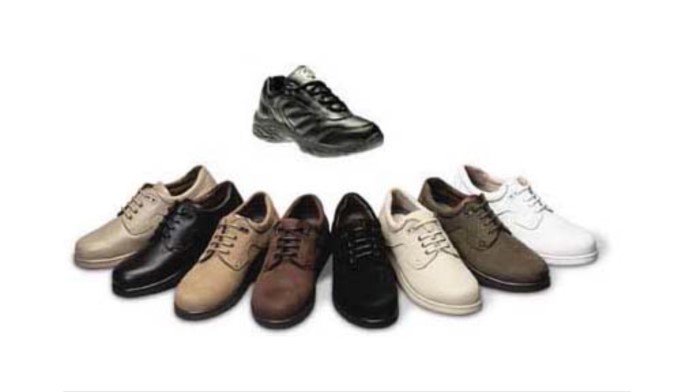 Lifehacker reports that shoe shopping should be done in the evening to ensure the best fitting shoes for the feet. As the day passes, the feet swell in size. Shoe shopping later in the day or in the evening ensures that the feet are at their largest when trying on shoes. While this slight increase in size would normally not make a significant difference, those looking for something supportive such as running shoes or shoes that will be worn all day should consider these slight changes important.
Lifehacker reports that shoe shopping should be done in the evening to ensure the best fitting shoes for the feet. As the day passes, the feet swell in size. Shoe shopping later in the day or in the evening ensures that the feet are at their largest when trying on shoes. While this slight increase in size would normally not make a significant difference, those looking for something supportive such as running shoes or shoes that will be worn all day should consider these slight changes important.
Finding a proper fitting shoe is important in reducing injuries and preventing foot problems. For more information contact Dr. Joshua David Scoll of Pennsylvania. Our doctor will treat your foot and ankle needs.
Proper Shoe Fitting
A common concern when it comes to foot health, having properly fitted shoes can help prevent injuries to the foot. Out feet affect our posture and gait, which in turn affects the biomechanics and overall bodily structure. With 33 joints, 26 bones, and over 100 ligaments, the potential for serious injury is much greater than one realizes. Although the feet cease growth in adulthood, they still change shape as they mature. Here are come factors to consider when it comes to investing in properly fitting shoes:
- Be sure the shoes fit correctly right away
- Ensure the ball of your foot fits comfortably in the widest portion of the shoes
- Even though they may look fashionable, improperly fitting shoes can either create adverse conditions or exacerbate existing ones you may already have
- Walk along a carpeted surface to ensure the shoes comfortably fit during normal activity
Keeping in mind how shoes fit the biomechanics of your body, keeping properly fit shoes is vitally important. Fortunately, it is not difficult to acquire footwear that fits correctly. Be sure to wear shoes that support the overall structure of your body. Do your feet a favor and invest in several pairs of well-fitted shoes today.
If you have any questions, please feel free to contact our offices located in Bensalem and Philadelphia, PA. We offer the newest diagnostic tools and technologies for your foot and ankle needs.
Blisters are More Common During the Summer Months
 While a blister is one of the most common foot conditions a person can develop, they are especially common during the summer because of the excessive heat. While most blisters will go away within a few days, those who are looking to treat their condition should avoid popping blisters and instead soak the feet. Popping should only be done if the blister is located in a weight-bearing area and the pain is too much. If a blister manages to pop on its own, clean the area with mild soap and water and dry it gently before applying a topical antibiotic.
While a blister is one of the most common foot conditions a person can develop, they are especially common during the summer because of the excessive heat. While most blisters will go away within a few days, those who are looking to treat their condition should avoid popping blisters and instead soak the feet. Popping should only be done if the blister is located in a weight-bearing area and the pain is too much. If a blister manages to pop on its own, clean the area with mild soap and water and dry it gently before applying a topical antibiotic.
Blisters on the feet are very painful and can become problematic if not treated properly. If you have any concerns about your foot and ankle needs contact Dr. Joshua David Scoll of Pennsylvania. Our doctor will treat your foot and ankle needs.
Foot Blisters
Foot blisters develop as a result of constantly wearing tight or ill-fitting footwear. This happens due to the constant rubbing from the shoe, which can often lead to pain.
What are Foot Blisters?
A foot blister is a small fluid-filled pocket that forms on the upper-most layer of the skin. Blisters are filled with clear fluid and can lead to blood drainage or pus if the area becomes infected.
How do Blisters Form?
Blisters on the feet are often the result of constant friction of skin and material, usually by shoe rubbing. Walking in sandals, boots, or shoes that don’t fit properly for long periods of time can result in a blister. Having consistent foot moisture and humidity can easily lead to blister formation.
Prevention & Treatment
It is important to properly care for the affected area in order to prevent infection and ease the pain. Do not lance the blister and use a band-aid to provide pain relief. Also, be sure to keep your feet dry and wear proper fitting shoes. If you see blood or pus in a blister seek attention from a doctor.
If you have any questions please contact our offices located in Philadelphia and Bensalem, PA. We offer the newest diagnostic tools and technology to treat your foot and ankle needs.
Wearing Softer Shoes or Going Barefoot Until Walking Can be Good for Infants and Toddlers
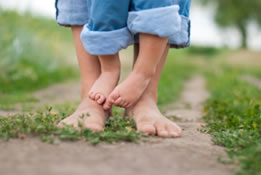 When it comes to purchasing shoes for your baby’s feet, many professionals believe that babies and toddlers should not wear firm shoes before they are fully walking to allow proper growth. “It is important that the muscles in toddlers’ feet are allowed to develop through natural stabilization,” stated Dr. Douglas Horne, UK podiatrist. Shoes during the early years should mostly be worn to protect the foot; otherwise going barefoot will help promote a better toe grip and stronger arch of the foot.
When it comes to purchasing shoes for your baby’s feet, many professionals believe that babies and toddlers should not wear firm shoes before they are fully walking to allow proper growth. “It is important that the muscles in toddlers’ feet are allowed to develop through natural stabilization,” stated Dr. Douglas Horne, UK podiatrist. Shoes during the early years should mostly be worn to protect the foot; otherwise going barefoot will help promote a better toe grip and stronger arch of the foot.
Infants and toddlers need to have fitted shoes. If your baby needs foot care, see Dr. Joshua David Scoll of Pennsylvania. Our doctor can help your baby’s foot and ankle necessities
Fitting Shoes for Infants
Taking care of a baby to ensure proper development is highly important and necessary to make sure that they grow up to be healthy and happy. Finding shoes for infants may be tricky for new parents because it is a new experience for everyone involved. Also, since infants cannot speak, they cannot tell you which one feels best, which hurts, and which styles they like more. Although often crying is a signal for them being unhappy, it is still difficult to know what fits.
Since their feet are so tiny, it might be easier to go around a store and try to see which shoes fit them best. Most infant shoes are very soft and you will not have to worry about fancy laces or intricate shoe designs. For infants, all that matters is that they are warm, well-protected and comfortable so that they can grow properly.
Once a baby is able to stand or start walking after they pass their crawling phase, it is important to change their shoes as often as they grow, and since they tend to grow and change fast, it is best to keep up with them to ensure safety and comfort.
If you have any questions, please feel free to contact our offices located in Philadelphia and Bensalem, PA. We offer the newest diagnostic tools and technologies for your foot and ankle needs.
More...
Seniors Around the Country Gather for the National Senior Games Despite Past Injuries
 This past July the Minneapolis metro area hosted the 2015 National Senior Games where nearly 12,000 seniors ages 50 and older completed in high activity events such as basketball, swimming, and volleyball. Despite many of these participants having previously suffered from foot and ankle injuries, making them even more susceptible to injury at this stage, the event was still a success. Health professionals do recommend, however, that seniors take extra precautions when participating in high impact activities such as tennis, golf, or running since these activities can have negative influences on the lower extremities.
This past July the Minneapolis metro area hosted the 2015 National Senior Games where nearly 12,000 seniors ages 50 and older completed in high activity events such as basketball, swimming, and volleyball. Despite many of these participants having previously suffered from foot and ankle injuries, making them even more susceptible to injury at this stage, the event was still a success. Health professionals do recommend, however, that seniors take extra precautions when participating in high impact activities such as tennis, golf, or running since these activities can have negative influences on the lower extremities.
Proper foot care is something many older adults forget to consider. For more information, consult with Dr. Joshua David Scoll from Pennsylvania. Our doctor will assist you with all of your podiatric concerns.
The Elderly and their Feet
As we age we start to notice many changes in our body, but the elder population may not notice them right away. Medical conditions may prevent the elderly to take notice of their foot health right away. Poor vision is a lead contributor to not taking action for the elderly.
Common Conditions
Neuropathy – can reduce feeling in the feet, and can hide many life threating medical conditions.
Reduced flexibility – prevents the ability of proper toenail trimming, and foot cleaning. If left untreated, it may lead to further medical issues.
Foot sores – amongst the older population can be serious before they are discovered. Some of the problematic conditions they may face are:
Gouging toenails affecting nearby toe
Shoes that don’t fit properly
Pressure sores
Loss of circulation in legs & feet
Edema & swelling of feet and ankles
Susceptible Infections
Diabetes and poor circulation can cause general loss of sensitivity over the years, turning a simple cut into a serious issue.
If you have any questions please contact our offices located in Philadelphia and Bensalem, PA. We offer the newest diagnostic and treatment technologies for all your foot and ankle needs.
Children’s Foot Ailments Are Often Treatable While They are Still Young
 Nearly 15% of children appear to have flat feet, but as most of these children grow older arches will develop. Unless children are complaining of pain there is no need to interfere with the growing process; however, seeing a podiatrist concerning the arches will not cause any harm and may put a parent’s mind at ease. Additionally, parents can easily tell if their children do have foot problems by looking at the wear and tear patterns on their shoes. Bringing in old shoes to a doctor’s visit can help determine if your child has any potential foot issues. In most cases foot problems can be treated while a child is still young since the bones are still soft.
Nearly 15% of children appear to have flat feet, but as most of these children grow older arches will develop. Unless children are complaining of pain there is no need to interfere with the growing process; however, seeing a podiatrist concerning the arches will not cause any harm and may put a parent’s mind at ease. Additionally, parents can easily tell if their children do have foot problems by looking at the wear and tear patterns on their shoes. Bringing in old shoes to a doctor’s visit can help determine if your child has any potential foot issues. In most cases foot problems can be treated while a child is still young since the bones are still soft.
Keeping an eye on your child’s foot growth is one of the best ways to help keep their feet healthy. If you have any concerns contact Dr. Joshua David Scoll of Pennsylvania. Our doctor will treat your foot and ankle needs.
Keeping Children's Feet Healthy
Having healthy feet in childhood can help prevent medical problems later in life, namely in the back and legs. As children grow, their feet require different types of care from birth to school-age.
Although babies do not walk yet, it is still very important to take care of their feet.
- Avoid putting tight shoes or socks on his or her feet
- Allow the baby to stretch and kick his or her feet to feel comfortable
As a toddler, kids are now on the move and begin to develop differently. At this age toddlers are getting a feel for walking, so don’t be alarmed if your toddler is unsteady or ‘walks funny’. Be sure the child wears comfortable and protective shoes so that they can grow into their feet properly.
As your child gets older, it is important to teach them how to take care of their feet
- Show them proper hygiene to prevent infections such as fungus
- Be watchful of any pain or injury
- Have all injuries checked by a doctor as soon as possible
- Comfortable, protective shoes should always be worn, especially at play
Children of all ages are constantly developing and growing, and as a parent you want to make sure that nothing is hindering their maturation.
If you have any concerns feel free contact our offices located in Philadelphia and Bensalem, PA. We offer the newest diagnostic tools and technology to treat your foot and ankle needs.
Dodgers Brett Anderson Suffers Achilles Tendon Injury
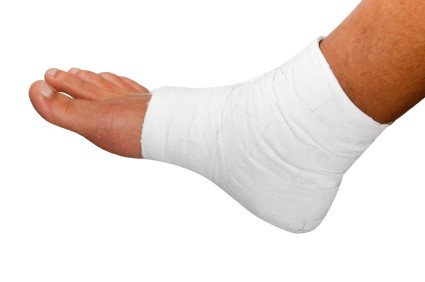 Brett Anderson of the Los Angeles Dodgers suffered an Achilles tendon injury after a game against the Atlanta Braves. At the time of the injury, Anderson was not sure if whether the discomfort in his Achilles tendon would be a minor or more major concern. “Hopefully,” Anderson said, “I caught it before it was anything major.” After the game against the braves, Anderson was seen standing in the clubhouse at Turner Field with his left foot in a walking boot. If he is forced to sit out for the rest of the season, Anderson will be joining players Hyun-Jin Ryu and Brandon McCarthy who both underwent season-ending operations.
Brett Anderson of the Los Angeles Dodgers suffered an Achilles tendon injury after a game against the Atlanta Braves. At the time of the injury, Anderson was not sure if whether the discomfort in his Achilles tendon would be a minor or more major concern. “Hopefully,” Anderson said, “I caught it before it was anything major.” After the game against the braves, Anderson was seen standing in the clubhouse at Turner Field with his left foot in a walking boot. If he is forced to sit out for the rest of the season, Anderson will be joining players Hyun-Jin Ryu and Brandon McCarthy who both underwent season-ending operations.
Achilles tendon injuries need immediate attention to avoid future complications. If you have any concerns contact Dr. Joshua David Scoll of Pennsylvania. Our doctor will treat your foot and ankle needs.
What is the Achilles Tendon?
The Achilles tendon is a tendon that connects the lower leg muscles and calf to the heel of the foot. It is the strongest tendon in the human body and is essential for making movement possible. Because this tendon is such an integral part of the body, any injuries to it can cause severe difficulties and should immediately be presented to a doctor.
What are the symptoms of an Achilles Tendon Injury?
There are various types of injuries that can affect the Achilles tendon. The two most common are Achilles tendinitis and ruptures of the tendon.
Achilles Tendinitis Symptoms
- Inflammation
- Dull to Severe Pain
- Increased blood flow to the tendon
- Thickening of the tendon
Rupture Symptoms
- Extreme pain and swelling in the foot
- Total immobility
Treatment and Prevention
Achilles tendon injuries are diagnosed by a thorough physical evaluation, which can include an MRI. Treatment involves rest, physical therapy, and in some cases, surgery. However, various preventative measures can be taken to avoid these injuries, such as:
- Thorough stretching of the tendon before and after exercise
- Strengthening exercises like calf raises, squats, leg curls, leg extensions, leg raises, lunges, and leg presses
If you have any questions please feel free to contact our offices located in Bensalem and Philadelphia, PA. We offer the newest diagnostic tools and technology to treat your foot and ankle needs.
Gout Often Misdiagnosed in Women
 Three years ago Kathleen Sundbye began feeling a painful burning sensation in her right foot that was quickly diagnosed as gout. Accordingly, many women are often misdiagnosed since gout is known to occur more likely in males. In recent years more and more women have been diagnosed with the disease; however, it seems to occur in different areas of the lower extremities compared to men. Most men experience gout pain in their knees, ankles, and feet while women will have it in their knees and toes.
Three years ago Kathleen Sundbye began feeling a painful burning sensation in her right foot that was quickly diagnosed as gout. Accordingly, many women are often misdiagnosed since gout is known to occur more likely in males. In recent years more and more women have been diagnosed with the disease; however, it seems to occur in different areas of the lower extremities compared to men. Most men experience gout pain in their knees, ankles, and feet while women will have it in their knees and toes.
Gout is a foot condition that requires certain treatment and care. If you have any concerns regarding gout, consult with Dr. Joshua David Scoll of Pennsylvania. Our doctor will assist you with all of your foot and ankle needs.
What is Gout?
Gout is a type of arthritis caused by a buildup of uric acid in the bloodstream. It often develops in the foot, especially the big toe area, although it can manifest in other parts of the body as well. Gout can make walking and standing very painful and is especially common in diabetics and the obese.
People typically get gout because of a poor diet. Genetic predisposition is also a factor. The children of parents who have had gout frequently have a chance of developing it themselves.
Gout can easily be identified by redness and inflammation of the big toe and the surrounding areas of the foot. Other symptoms include extreme fatigue, joint pain, and running high fevers. Sometimes corticosteroid drugs can be prescribed to treat gout, but the best way to combat this disease is to get more exercise and eat a better diet.
If you have any questions, please feel free to contact our offices located in Philadelphia and Bensalem, PA. We offer the newest diagnostic and holistic treatment protocols for all your individual foot and ankle needs.
California Woman Breaks Both Ankles and Dolphin Jumps on Boat
 A summer boating trip took a dangerous turn when a dolphin jumped into the boat of a Californian family breaking the ankles of one of the passengers. Dirk and Chrissie Frickman were celebrating their 18th wedding anniversary watching dolphins from their boat in Laguna Nigel. One dolphin seemed to get a little too playful when it jumped into their boat knocking over Chrissie Frickman and just missing their daughter. After being rushed to the hospital, Chrissie was left with two broken ankles and the dolphin was returned back into the water.
A summer boating trip took a dangerous turn when a dolphin jumped into the boat of a Californian family breaking the ankles of one of the passengers. Dirk and Chrissie Frickman were celebrating their 18th wedding anniversary watching dolphins from their boat in Laguna Nigel. One dolphin seemed to get a little too playful when it jumped into their boat knocking over Chrissie Frickman and just missing their daughter. After being rushed to the hospital, Chrissie was left with two broken ankles and the dolphin was returned back into the water.
Broken ankles need immediate treatment. If you have any concerns about your feet and ankles contact Dr. Joshua David Scoll, DPM of Pennsylvania. Our doctor will treat your foot and ankle needs.
Broken Ankles
A broken ankle is experienced when a person fractures their tibia or fibula in the lower leg and ankle area. Both these bones are attached at the bottom of the leg and combine to form what we know to be our ankle.
When a physician is referring to a break of the ankle, he or she is usually referring to a break in the area where the tibia and fibula are joined to create our ankle joint. Ankles are more prone to fractures because the ankle is an area that suffers a lot of pressure and stress. There are some obvious signs when a person experiences a fractured ankle and the following symptoms may be present.
Symptoms of a Fractured Ankle
- Excessive pain when the area is touched or when any pressure is placed on the ankle
- Swelling around the area
- Bruising of the area
- Area appears to be deformed
If you suspect an ankle fracture, it is recommended to seek treatment as soon as possible. The sooner you have your podiatrist diagnose the fracture, the quicker you’ll be on the way towards recovery.
If you have any questions please feel free to contact our offices located in Philadelphia and Bensalem, PA. We offer the newest diagnostic tools and technology to treat your foot and ankle needs.
